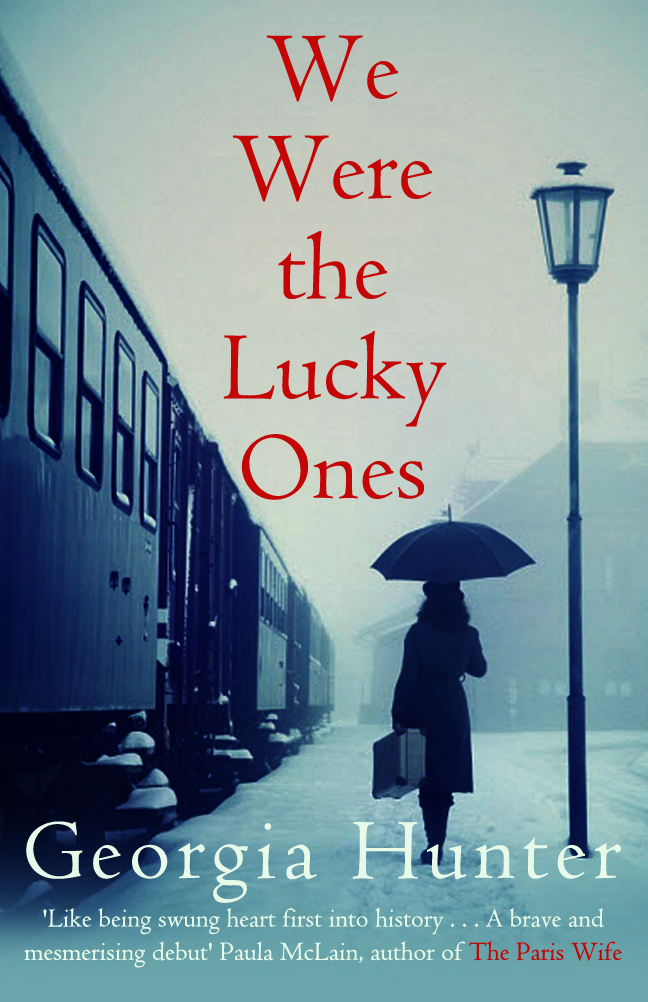Interview with Georgia Hunter 
How did you come across this story? What inspired you to write about it?
I discovered this piece of my family history at fifteen, when my high school English teacher tasked our class with interviewing a relative about our ancestral pasts. My grandfather had died the year before and with his memory so fresh, I decided to sit down with my grandmother. It was in that interview that I learned I was a quarter Jewish, and that I came from a family of Holocaust survivors. Six years later, at a family reunion, I was introduced to pieces of the greater Kurc saga—to stories unlike any I’d ever heard before. Nearly a decade would pass, however, before I gathered the courage to unearth and record my family’s remarkable Holocaust history.
What were your main sources for your research? How did you organize everything? (That is, got any tips for fellow writers?)
My research began in 2008 when I set off with a digital voice recorder to interview a relative in Paris. From there I flew to Rio de Janeiro and across the States, meeting with cousins and friends and strangers—anyone with a story to share. I saved all of my recorded interviews to iTunes and referred back to them frequently. The family’s narrative took shape, at first, in the form of a timeline, which I peppered with historical details and color-coded by relative to help keep track of who was where/when. Where there were gaps in my timeline, I looked to outside resources—to archives, museums, ministries, and magistrates—in hopes of tracking down relevant information. I was amazed at what kinds of information I was able to find. Once my timeline was complete, I plotted an outline and chapter summaries and from there, began the terrifying task of putting my story to paper!
*For more tips on how to conduct your own ancestry search, you can check out the Ancestry Search Tips page on my website.
What were the biggest challenges you faced either in the research, the writing, or structuring the plot?
The Kurc family scattered at the start of WWII – their paths to survival spanned five continents over six years. Once I realized the (enormous!) scope of my story, the idea of telling it in a cohesive, digestible narrative was daunting, to say the least. The Kurcs’ diaspora meant that my chapters would have to be written from different perspectives. I thought long and hard on how to differentiate each of my characters, and how to convey thought long and hard on how to differentiate each of my characters, and how to convey those differences on the page in a way that would allow readers to remember who was who as they bounced between storylines. I also created a family tree, which appears at the front of the book, as a tool to help readers remember the characters and relationships.
Every writer has to leave something on the cutting floor. What’s on yours?
Uncovering my family history required so much digging that I was tempted to use every morsel of information I could find! That said, one element of the narrative I opted to omit out where the storylines of a handful of extended family members – great aunts and distant cousins – who also managed to survive the Holocaust. I felt it was already a lot to ask of my readers to keep track of a set of parents, five children/their significant others, and a grandchild. And so, in the end, I decided to narrow my cast of characters to those dozen or so in my grandfather’s nuclear family in order to keep the story focused – and believable.
 Hunter penned her first “novel” when she was four years old, and titled it Charlie Walks the Beast after her father’s recently published sci-fi novel, Softly Walks the Beast. When she was eleven, she pitched an article—an Opinion piece on how she’d spend her last day if the world were about to come to an end—to the local newspaper. Since that debut in the Attleboro Sun Chronicle, her personal essays and photos have been featured in places like the New York Times “Why We Travel,” in travelgirl magazine, and on Equitrekking.com. A graduate of the University of Virginia, Hunter has worked in branding and marketing and is currently a freelance copywriter in the world of adventure travel, crafting marketing materials for outfitters such as Austin Adventures and The Explorer’s Passage. She lives in Connecticut with her husband and their five-year-old son.
Hunter penned her first “novel” when she was four years old, and titled it Charlie Walks the Beast after her father’s recently published sci-fi novel, Softly Walks the Beast. When she was eleven, she pitched an article—an Opinion piece on how she’d spend her last day if the world were about to come to an end—to the local newspaper. Since that debut in the Attleboro Sun Chronicle, her personal essays and photos have been featured in places like the New York Times “Why We Travel,” in travelgirl magazine, and on Equitrekking.com. A graduate of the University of Virginia, Hunter has worked in branding and marketing and is currently a freelance copywriter in the world of adventure travel, crafting marketing materials for outfitters such as Austin Adventures and The Explorer’s Passage. She lives in Connecticut with her husband and their five-year-old son.
Missed our previous Five for Friday? Find last week’s interview with Anna Mazzola here. Want to binge read our interviews with fantastic authors? Check out our interviews with Essie Fox, Ami McKay, and Eva Stachniak.


